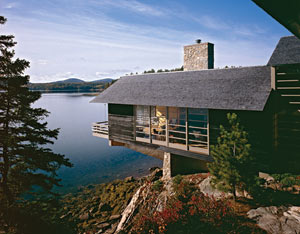Summerguide 2010
Painter Clara Fargo Thomas created canvases to get lost in. Architect George Howe set out to build her a masterpiece to live in. The result was Fortune Rock.
By Brad Emerson
 Nineteen-thirty-seven was a very good year for houses built on rocky sites overlooking water. In Italy, writer Curzio Malaparte was building a radical house on a rock outcropping near Capri, while just outside Mill Run, Pennsylvania, Frank Lloyd Wright was working for the Kaufmann family (of department store fame) on Fallingwater, a stunning residence cantilevered over a waterfall. And on Maine’s Mount Desert Island, architect George Howe was creating Fortune Rock, dramatically cantilevered over Somes Sound, for artist Clara Fargo Thomas.
Nineteen-thirty-seven was a very good year for houses built on rocky sites overlooking water. In Italy, writer Curzio Malaparte was building a radical house on a rock outcropping near Capri, while just outside Mill Run, Pennsylvania, Frank Lloyd Wright was working for the Kaufmann family (of department store fame) on Fallingwater, a stunning residence cantilevered over a waterfall. And on Maine’s Mount Desert Island, architect George Howe was creating Fortune Rock, dramatically cantilevered over Somes Sound, for artist Clara Fargo Thomas.
Thomas was a Wells Fargo heiress who had achieved renown as a muralist and scenic designer in New York City, where she lived in a large, traditional town house with her husband, financier Joseph B. Thomas. “Slim, golden-haired, youthful-looking, mural-painting, party-giving Clara Thomas” was how she was described in an October, 1940 Spokesman Review article. Thomas created works that included The Coronation Mural at Selfridge’s in London and The World of Steel at the U.S. Steel Pavilion at the 1939-1940 New York World’s Fair.
Her architect, George Howe, began his career at the very traditional firm Mellor, Meigs, & Howe, famous for their elegantly conceived, understated, and texturally rich houses on the Main Line of Philadelphia. After leaving the firm, Howe formed a partnership with modernist architect William Lescaze, with whom he designed the Philadelphia Savings Fund Society Building, considered to be the world’s first International Style skyscraper. In 1934, firmly established as a pioneer modernist and with his earlier design roots far behind him, Howe struck out on his own, and in 1936, Clara Thomas approached him to design her summer compound on a spectacular site at the head of Somes Sound, a fjord-like body of water that almost splits Mount Desert Island in two.
Howe’s prior training in vernacular design and his extraordinary feel for materials stood him in good stead for the project. Using the simple shapes and building materials (such as weathered clapboard, granite, and gray shingles) characteristic of traditional Maine architecture to anchor the house to its rugged location, Howe proceeded to create something new. The resulting stripped-down shapes create an almost cubist composition, and the house’s defining feature–a spectacular living room cantilevered on concrete bridge trusses above Somes Sound–gives the house its modernist credibility. Handsome, veneered plywood was used for all the walls and shelving throughout the interior. The exterior walls were stained gray, and the underside of the eaves and interior ceilings were painted a gray blue that answered the sky. In the dining room and entrance hall, a mural painted by Mrs. Thomas, depicted the wreck of the Joseph B. Thomas, a ship owned by her husband’s ancestor. The wreck took place off Fortunes Rocks in southern Maine, thus giving the house its name.
Down a short flight of steps was the living room, where the lines between structure and nature, indoors and outdoors, were blurred. On three sides, large, floor-to-ceiling sliding doors–recalling shoji screens–opened wide, with only a railing at the sides. The walls were mirrored in a grid that seamlessly echoed the panes of the windows, further blurring the distinction between indoors and outdoors. Furnishings were chosen in the modernist style from the best designers of the time.
The house was famous in its day and was featured in a Museum of Modern Art exhibition on modern buildings, as well as in several leading architectural publications. What seemed radical and modern 70 years ago still holds up to scrutiny in the 21st century, and Fortune Rock remains one of the finest modern houses in Maine–and perhaps anywhere.
In the 1980s, the house was purchased by the Berwind family, who undertook a sympathetic restoration and redecoration of the house, which by that time was a bit timeworn. Gone, unfortunately, was Clara Thomas’s dining room mural.





0 Comments
Trackbacks/Pingbacks